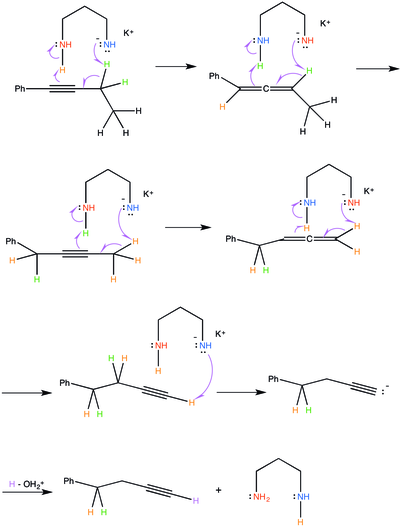User:Mdbreshears/sandbox
NEED CITATIONS STILL (main citation already used in original article)
Edits:
Great work! There is a good flow and structure to this article. I like how you linked a lot of the keywords to existing wikipedia articles. I think you did a good job at describing how the mechanism works. Two suggestions: One is to move the initiation of 3-aminopropylamine up underneath the first paragraph where you are discussing how the mechanism works, I believe that could help the reader out. Two, make the first scheme just a tad larger so you can see it without having to click on it. Other than that just remember to add your references once you transfer to the main wiki page.
-Matt
Mechanism[edit]

The alkyne zipper reaction requires a strong base to proceed. Potassium hydride, a volatile strong base, can be used to initiate the reaction. First, the hydride plucks a proton off of one of the amine groups of the 3-aminopropylamine. The electrons from the hydrogen-nitrogen bond kick onto the nitrogen atom. This is favorable because the nitrogen atom is electronegative and can hold the resulting negative charge. Hydrogen gas (H2) bubbles off, driving the reaction forward. The positively charged potassium ion stabilizes the resulting negatively charged 3-aminopropylamine.

The reactive 3-aminopropylamine anion removes a proton from the less-substituted carbon adjacent to the alkyne reagent. The steric hindrance created by the substituted groups prevents the 3-aminopropylamine from attacking any available protons. The negatively charged amine group does this, as anions often act as good nucleophiles. Subsequently, the electrons from the carbon-hydrogen bond move to form a carbon-carbon bond. This forces the electrons from one of the two pi-bonds on the alkyne to attack the amine group on the 3-aminopropylamine that was not originally holding the negative charge. The nitrogen in this amine group can hold the extra negative charge because nitrogen is an electronegative element. The resulting intermediate is an allene, where one carbon is double-bonded to another carbon that is double-bonded to the next carbon. Additionally, there is a regenerated 3-aminopropylamine anion that will continue the reaction. This process is concerted.
The 3-aminopropylamine anion attacks the same lesser-substituted carbon adjacent to the allene, removing a proton and catalyzing a similar process, where the electrons from the carbon-hydrogen bond move to form a triple-bond (an alkyne). The pi-electrons that compose the neighboring double-bond in the allene are forced to attack the second amine group on the 3-aminopropylamine. In keeping with the previous step, the amine group that holds the negative charge acts as the nucleophile and the amine group that does not hold that negative charge acts as an electrophile.
These steps will be repeated, essentially moving the alkyne along the alkane chain until a terminal alkyne is achieved. Once a terminal alkyne is achieved, the 3-aminopropylamine anion will attack and remove the terminal proton. However, the process stops there because the carbon-hydrogen bond electrons cannot form an additional pi-bond on top of the alkyne. Therefore, an acetylide anion is produced. A mild acid workup will quench the acetylide anion and the 3-aminopropylamine anion.

